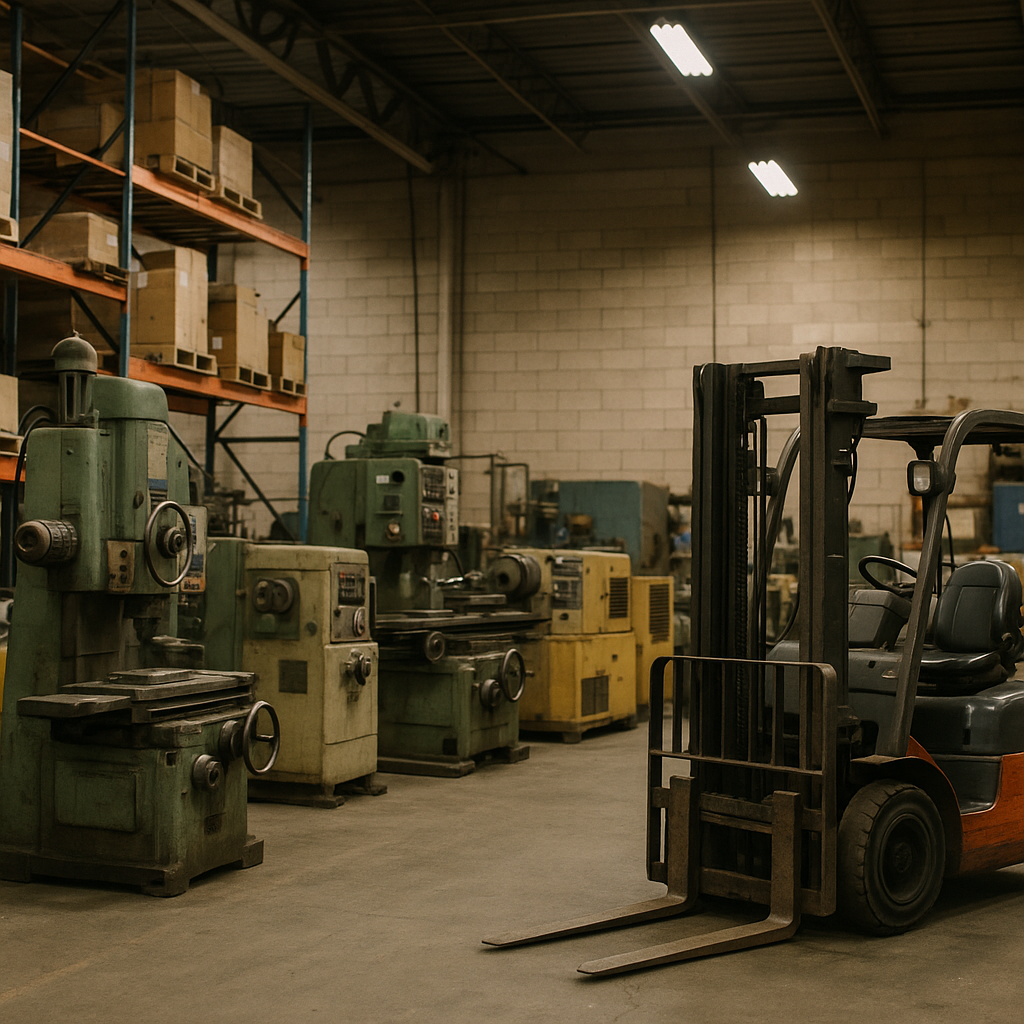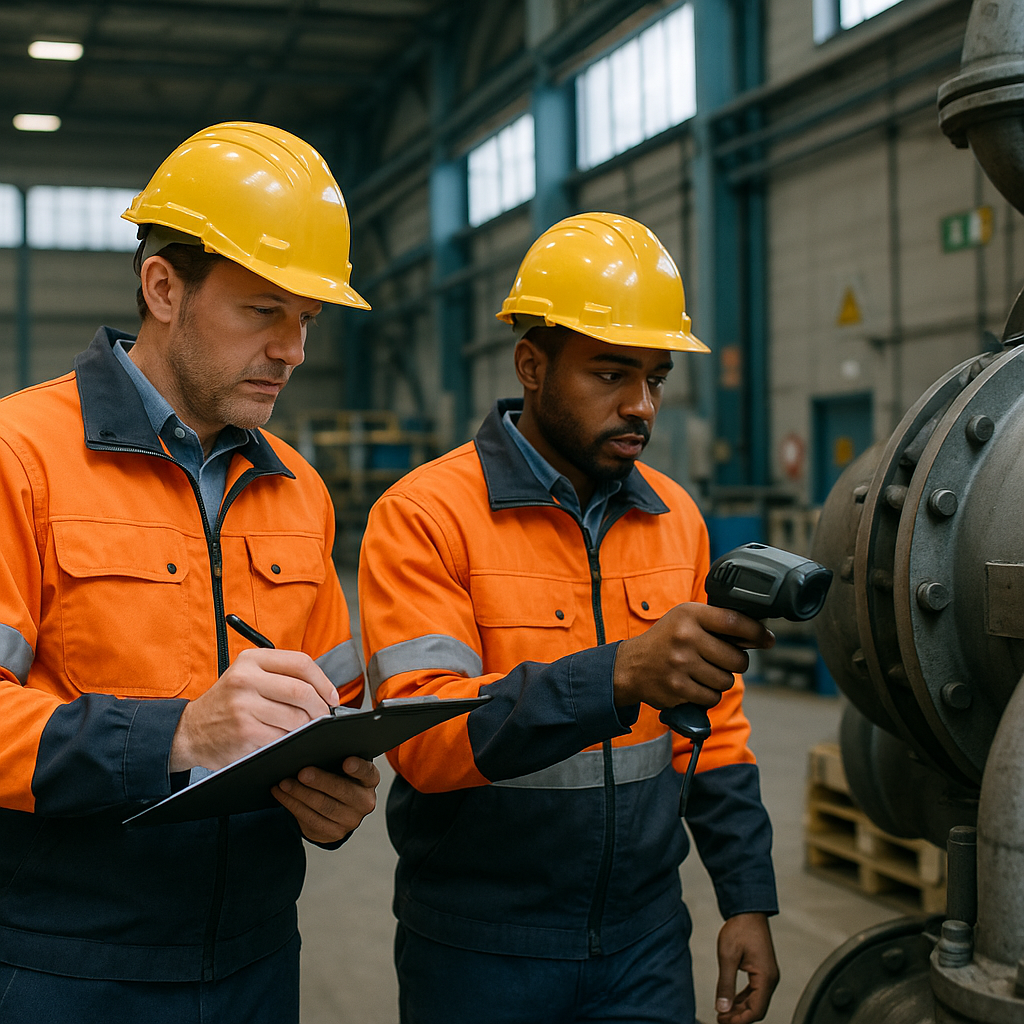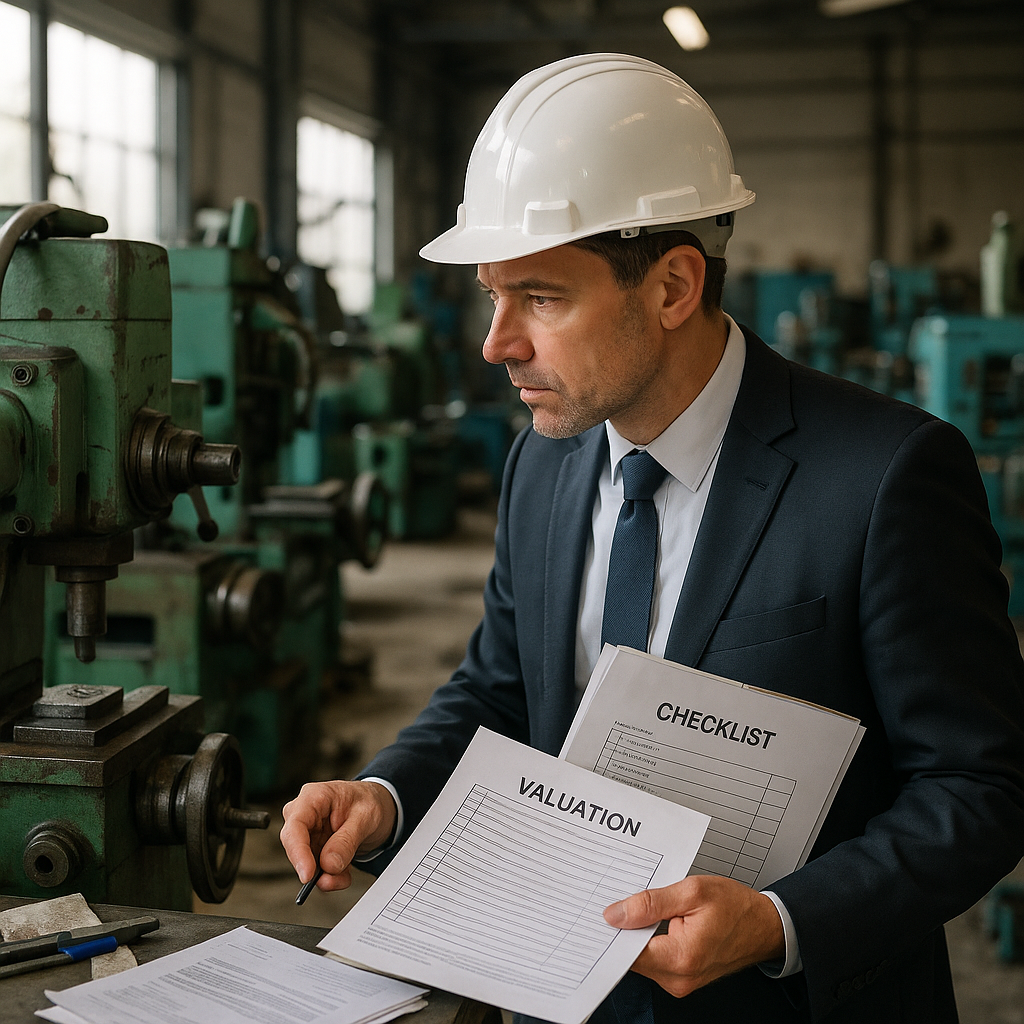5901 Botham Jean Blvd, Dallas, TX 75215
Exploring Asset Recovery for Industrial Machinery
July 26, 2025Asset recovery for industrial machinery transforms dormant capital into immediate cash flow. When manufacturing equipment sits unused in warehouses or facilities, it represents locked-up value that could be utilized for business growth. This practical process converts surplus, idle, or obsolete industrial machinery into liquid assets.
The concept is simple yet powerful. Companies identify equipment they no longer need, evaluate its market worth, and convert it to cash through various methods. These methods typically include direct purchases, consignment sales, specialized auctions, or private treaty sales with interested buyers.
For many industrial operations, asset recovery serves multiple purposes beyond generating revenue. It frees valuable warehouse space that could be used more productively. It also allows businesses to reinvest recovered capital into current operations or new equipment that better serves present needs. Perhaps most importantly, it keeps functional equipment in circulation rather than landfills, supporting sustainability goals by reusing industrial resources.
What Types of Industrial Assets Can Be Recovered?

During plant liquidation or facility closure, a wide variety of industrial assets can be recovered for resale, refurbishment, or recycling. From small components to massive machinery, these assets often retain substantial value even after a facility ceases operations. Understanding what can be recovered helps facility owners maximize return on investment while contributing to sustainable resource management.
Industrial asset recovery typically focuses on these major categories:
Power Generation and Electrical Equipment
Electrical components are among the highest-value recoverable assets in industrial settings. These include:
- Transformers and substations
- Circuit breakers and switchgear
- Diesel and natural gas generators
- Turbines (gas, steam, and electric)
- Control panels and electrical busway
- Extensive copper wiring and cabling
These items contain valuable metals like copper and aluminum, and many can be refurbished for direct reuse in other facilities, making them particularly desirable during asset recovery.
Manufacturing Machinery and Production Lines
Core production equipment often represents significant value and includes:
- CNC machines and metalworking tools
- Assembly line components
- Robotic automation equipment
- Printing and packaging machinery
- Industrial ovens and furnaces
- Production line conveyor systems
- Filter presses and mixers
Mechanical and Process Equipment
Essential mechanical systems that support facility operations include:
- Pumps, motors, and compressors
- Industrial chillers and HVAC systems
- Material handling equipment (forklifts, hoists, cranes)
- Gearboxes and industrial bearings
- Heat exchangers and pressure vessels
- Storage tanks and silos
- Industrial blowers and vacuum systems
Even older mechanical equipment contains valuable components and metals that can be recovered during liquidation.
Support and Maintenance Resources
Beyond primary machinery, facilities typically contain valuable support assets:
- MRO (Maintenance, Repair, Operations) inventory
- Spare parts and components
- Industrial tools and equipment
- Laboratory and testing equipment
- Industrial shelving and storage systems
- Office equipment and furniture
These supporting assets are often overlooked but can provide significant recovery value when properly inventoried.
Infrastructure and Building Components
The facility itself may contain recoverable elements:
- Structural steel and metal framing
- Industrial lighting systems
- Copper piping and conduit
- Air handling equipment
- Fire suppression systems
- Mezzanines and walkways
During plant liquidation, specialized asset recovery experts perform comprehensive assessments to identify all salvageable items. They evaluate each asset’s potential for direct resale, refurbishment, or material recycling to determine the most profitable recovery approach.
The scope of recovery can range from selective high-value items to complete plant liquidations, where virtually everything from the facility is dismantled, removed, and marketed for maximum value.
[[artifact_table]]Typical Value Recovery Rates by Asset Category[[/artifact_table]]Professional asset recovery services handle everything from inventory assessment and valuation to dismantling, removal, and re-marketing of equipment, ensuring compliance with environmental regulations while maximizing financial returns from otherwise idle assets.
How Does the Asset Recovery Process Work?

The asset recovery process is a methodical approach that organizations use to maximize the value of unused or end-of-life assets. This structured methodology efficiently recovers valuable resources while minimizing disruption to ongoing operations.
Step 1: Initial Consultation and Site Evaluation
The process starts with a thorough consultation to understand your specific needs and objectives. Recovery specialists visit your facility to assess the project scope, identify potential challenges, and develop a preliminary plan. This initial step lays the foundation for a successful recovery operation.
During this phase, specialists evaluate your operational constraints and develop a timeline that fits your schedule. They also identify any regulatory or environmental considerations to address throughout the recovery process.
Step 2: Equipment Inventory and Condition Assessment
After the initial consultation, a detailed inventory of all assets is conducted. Each item is cataloged with relevant specifications, including make, model, age, and operational status, creating a basis for accurate valuation.
Specialists then assess the condition of each asset through testing and inspection. They document the working status, identify missing components, and note the cosmetic condition. This detailed assessment helps determine the most appropriate recovery strategy for each item.
Step 3: Market Valuation and Recovery Strategy Development
Using the inventory and condition assessment, recovery specialists determine the current market value of your assets. They analyze market trends, demand patterns, and resale opportunities to establish realistic value expectations.
Based on this valuation, a customized recovery strategy is developed that aligns with your objectives. This strategy identifies which items should be remarketed, repurposed, or recycled to maximize financial returns while meeting sustainability goals.
Step 4: Marketing to a Network of Buyers
With a strategy in place, assets are marketed to an established network of qualified buyers. Recovery specialists leverage industry connections, digital platforms, and targeted marketing approaches to reach potential purchasers.
This marketing phase is crucial for achieving optimal returns. Connecting with the right buyers who understand the value of your equipment can yield significantly better results than generic disposal methods.
Step 5: Handling Logistics and Removal
Once buyers are secured, the logistics phase begins. This includes coordinating the dismantling, packaging, and transportation of assets from your facility. Recovery specialists manage all aspects of this process, ensuring proper handling of sensitive equipment.
Careful planning and execution minimize disruption to your ongoing operations. Specialists work within your schedule and follow established protocols to ensure a smooth asset transition from your facility.
Step 6: Providing Detailed Documentation and Payment
The final step involves comprehensive documentation of all recovered assets, including sales, recycling, or proper disposal. This documentation serves as a crucial record for accounting, tax, and sustainability reporting purposes.
Payments are processed according to agreed terms, providing transparent reporting on the value recovered from each asset. This financial reconciliation completes the process and offers clear visibility into the results of the recovery effort.
Throughout each step, asset recovery specialists ensure a seamless experience that maximizes value while minimizing the administrative burden on your organization. The systematic approach ensures nothing is overlooked and that you receive the greatest possible return on your surplus assets.
What Factors Affect Industrial Asset Value?

The value of industrial assets varies depending on multiple factors. Identifying these factors enables organizations to make informed decisions about equipment purchases, maintenance schedules, and potential recovery values.
Equipment Type and Specialization
The type of equipment significantly affects its value. Machinery designed for specific industrial applications often has higher prices than general-purpose equipment. For example, a custom semiconductor manufacturing system with proprietary technology may retain more value than standard material handling equipment that is widely available.
Industry-specific assets often maintain stronger values when they serve growing sectors. Medical imaging equipment, specialized CNC machinery, and automation systems tend to yield better recovery values than common industrial tools that have numerous alternatives in the marketplace.
Age and Technological Relevance
The age of equipment impacts value, but not always as expected. While newer equipment typically commands higher prices, technological relevance can be more important than age. A five-year-old machine with outdated technology could be worth less than a ten-year-old model with current production features.
The rate of technological advancement varies by industry, affecting how quickly equipment becomes obsolete. For instance, IT equipment depreciates rapidly due to continuous innovation, while certain industrial machinery with simple mechanical functions may retain value for decades if maintained properly.
Physical Condition and Maintenance History
The physical state of industrial assets is a visible factor affecting value. Equipment with minimal wear and no visible damage will usually command higher prices than machinery with operational issues. Regular maintenance extends both the useful life and recoverable value of industrial assets.
Comprehensive maintenance records are valuable during the valuation process. Machinery with detailed service histories, timely repairs, and regular preventive maintenance generally yields 15-25% higher recovery values than identical equipment lacking proper documentation. Professional evaluators thoroughly inspect for signs of proper care and operation within manufacturer specifications.
Market Demand and Economic Conditions
Market demand plays a significant role in determining industrial asset values. Equipment serving thriving industries typically maintains stronger values, whereas assets from declining sectors may face devaluation. Supply chain disruptions can temporarily boost used equipment values when new machinery faces long lead times.
Economic conditions cause market fluctuations impacting industrial asset values. During downturns, surplus equipment can flood the market, potentially lowering values. Conversely, during economic growth, demand for quality used equipment often rises, strengthening recovery values.
Brand Reputation and Manufacturer Support
Equipment from manufacturers known for quality, reliability, and longevity often commands premium prices. Brands like Caterpillar, Siemens, and John Deere have stronger resale values due to their performance records and engineering excellence.
Manufacturer support is crucial in valuation. Equipment from companies with extensive parts inventories, technical support, and service for older models retains more value than equipment from manufacturers who have stopped support or gone out of business.
Geographic Location and Accessibility
The location of industrial assets affects their recoverable value. Equipment in high industrial concentration areas yields better returns due to lower transportation costs and stronger local demand. Conversely, equipment in remote locations may experience value reductions due to relocation logistics expenses.
Regional regulatory differences also impact valuation. Equipment meeting stricter environmental or safety standards maintains better value in highly regulated markets with substantial compliance costs for new equipment.
Documentation and Transferability
Complete documentation enhances industrial asset value. Equipment with original manuals, warranty information, calibration records, and operational guides generally commands higher prices. Assets with transferable software licenses or warranties offer stronger value propositions than those needing new licenses.
The ease of dismantling, transporting, and reinstalling equipment influences its market value. Modular systems designed for easy relocation tend to maintain stronger values than customized installations requiring specialized expertise for movement and reinstallation.
[[artifact_table]] Factors Affecting Industrial Asset Value and Their Impact [[/artifact_table]]Professional Valuation Expertise
Due to the complex interplay of these factors, professional asset recovery firms provide invaluable expertise in determining accurate valuations. These specialists analyze market conditions, assess physical condition, evaluate technological relevance, and consider demand factors to establish realistic recovery values.
Working with recovery professionals provides organizations with comprehensive market knowledge accounting for regional variations, industry trends, and specific equipment categories. This expertise helps set realistic expectations and develop effective strategies to maximize recovery values.
What Are the Benefits of Professional Asset Recovery Services?
Professional asset recovery services convert idle or surplus equipment into valuable capital, allowing businesses to focus on core operations. These services offer expertise and resources that most organizations lack internally. Here are the key advantages they provide for businesses seeking to reclaim value from unused assets.
Expertise in Equipment Valuation
Professional asset recovery specialists possess market knowledge that enables them to accurately assess the value of surplus equipment. Unlike internal teams that may undervalue assets, these experts understand current demand trends across industries and can identify all potential assets accurately.
Recovery specialists conduct detailed market analyses to determine fair market value, supported by thorough condition reports. This expertise prevents businesses from losing money through undervaluation or missed recovery opportunities.
Access to Extensive Buyer Networks
A major advantage of professional recovery services is their established network of qualified buyers. These specialists maintain connections with industry-specific purchasers worldwide who actively seek specific equipment types.
Recovery firms know where demand exists for particular assets and which platforms will best reach the right market. This targeted approach connects sellers with buyers willing to pay optimal prices, a feat most businesses can’t achieve on their own.
Streamlined Logistics and Removal
The physical aspects of asset recovery are challenging. Industrial equipment is large, heavy, and requires specialized handling. Professional services manage the entire removal process, including rigging, dismantling, and transportation.
This comprehensive approach eliminates the need for businesses to coordinate complex logistics or risk improper handling that could damage assets. Recovery specialists handle everything from inventory to shipping, ensuring safe and efficient removal.
Maximized Return on Investment
Professional asset recovery services consistently deliver higher returns than DIY approaches. By combining accurate valuations, targeted marketing, and efficient processes, these specialists maximize financial recovery from surplus assets.
While there is an upfront cost to hiring professional services, the increased recovery value typically far exceeds this investment. Many specialists work on a contingency basis, aligning their motivation with the client’s financial interests.
Minimized Operational Disruptions
Attempting asset recovery internally diverts time and resources from core business activities. Professional services allow company personnel to stay focused on their primary responsibilities rather than the complex recovery process.
The “set it and forget it” approach means businesses can continue normal operations uninterrupted while experts handle recovery in the background, minimizing downtime and maintaining staff focus on revenue-generating tasks.
Regulatory Compliance Assurance
Asset recovery involves navigating various legal regulations. Professional recovery specialists ensure all actions comply with relevant laws, minimizing legal risks for clients.
Their understanding of legal intricacies prevents costly mistakes and regulatory violations, providing peace of mind that assets are handled ethically and legally.
End-to-End Process Management
Professional asset recovery offers comprehensive management from start to finish. This includes initial consultations, detailed evaluations, customized planning, strategy execution, and transparent result reporting.
Every step is professionally managed, documented, and reported, from inventory assessment to final payment, ensuring complete visibility throughout the process.
[[artifact_table]] Comparison of Professional vs. DIY Asset Recovery Approaches [[/artifact_table]]For businesses with surplus equipment or decommissioning facilities, professional asset recovery services offer an efficient way to reclaim value. Leveraging specialized expertise and established processes, these services help convert idle equipment into working capital while minimizing management resources.
Conclusion: Maximizing Value Through Industrial Asset Recovery

Industrial asset recovery offers a strategic approach for businesses aiming to unlock capital tied up in idle or obsolete equipment. When implemented effectively, this process turns underutilized assets into valuable financial resources, allowing for reinvestment into core business operations. Financial benefits extend beyond immediate capital recovery, also reducing storage costs, streamlining operations, and improving inventory management.
Collaborating with experienced asset recovery professionals enables businesses to determine the best recovery method for each asset—whether through redeployment, reconditioning, resale, or recycling. This strategic approach not only maximizes financial returns but also supports sustainability initiatives by extending the lifecycle of industrial equipment and minimizing waste. For companies facing equipment obsolescence or facility closures, an effective asset recovery plan can transform potential liabilities into significant opportunities.
Ready to unlock the hidden value in your industrial assets? Contact Okon Recycling at 214-717-4083 for expert guidance on maximizing returns through strategic asset recovery solutions.
